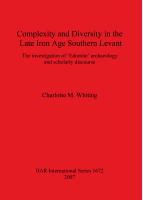Description
BOOK DESCRIPTIONThis study highlights a range of theoretical problems concerning Levantine Iron Age archaeology. Following the introduction, Chapter 2 provides the background for the study as a whole, tracing the archaeological study of the Iron Age southern Levant from the early nineteenth century to the present day. This highlights how and why archaeologists have changed their ideas about the narrative in question through time whilst also retaining a number of key ideas. Chapter 3 traces the archaeological study of 'Edomite' archaeology in the southern Levant in particular. Chapter 4 begins the critique of the key ideas and assumptions that underpin 'Edomite' archaeology by demonstrating that the individual historical sources used as evidence when discussing the 'Edomites' are not simply sources of factual information about the Iron Age. Chapter 5 takes a similarly critical approach to the methods of archaeological excavation, interpretation, and analysis used in south Levantine Iron Age archaeology. Chapter 6 completes the critique of the central ideas that form the basis of 'Edomite' archaeology by discussing the central tenets of archaeological theory concerning the relationship between material culture and identity that are required to support this idea. Chapter 7 outlines the methodology used in this study, which was designed to test whether specific ceramic types do in fact support the present interpretation of the late Iron Age southern Levant. The results of the analysis using this methodology are presented inChapter 8. In Chapter 9 the implications of the preceding chapters are discussed and an interpretation of the evidence which does not rely on traditional problematic assumptions will be presented. Final conclusions are drawn in Chapter 10.











